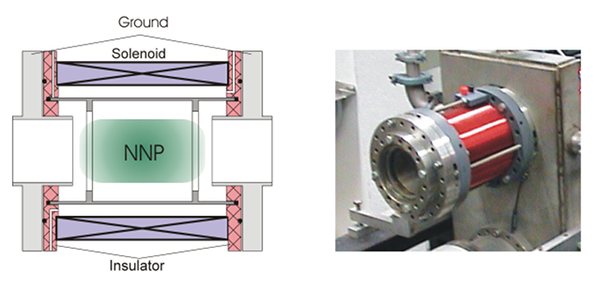Contents
| Gabor-Lens | Year |
| Remarks on historical development | - - - |
| First GL investigated in our group (Baby) | 1990 |
| Big-GL | 1997 |
| Double-GL | 2000 |
| High-Field-GL | 2006 |
| Three Segmented GL (HERBERT) | 2008 |
| Simulations | - - - |
Objectives
| . |
| Space Charge Lenses like the Gabor Plasma Lens (GPL) make use of the electric field of the trapped single component plasma to focus particle beams. The GPL consists of a cylindric anode, two ground electrodes and a solenoid. The solenoid provides a radial confinement for the electron cloud, whereas the anode with a positive voltage provides the axial confinement for the electrons in potential well (s. fig. 1). |

|
| Fig.1. Cross-sectional view of a Gabor-lens (left) and image of a copy of the first Gabor-lens constructed at Goethe-Universit (right) |
|
The residual gas ions are produced due to the electron impact ionisation in the lens volume also. After production, they are accelerated by an electric field longitudinally and leave the lens volume. By measuring of energy distribution of outgoing ions we can yield information about the current plasma state. Besides the optical spectroscopy of the electron plasma this is an important scope of analysis. Experiments using a high field Gabor Plasma Lens have shown a correlation between the thermalisation of the enclosed electron cloud and the focussing quality. Especially a nonuniform density distribution of the confined Nonneutral Plasma (NNP) leads to instabilities and therefore a radial change of the density profile. In this regard the quality of illustration depends on thermodynamic properties of the NNP. Therefore the primary concern by using Gabor lenses is the investigation of the plasma parameters in the current state of the confined plasma cloud for focussing of intense ion beams. |